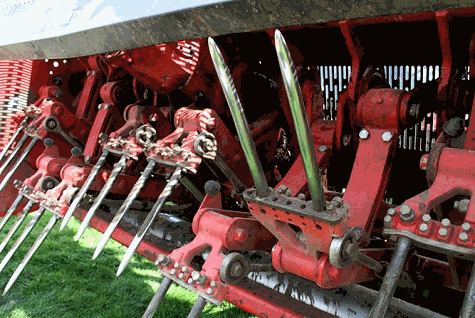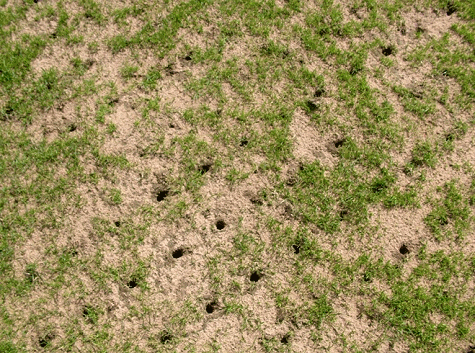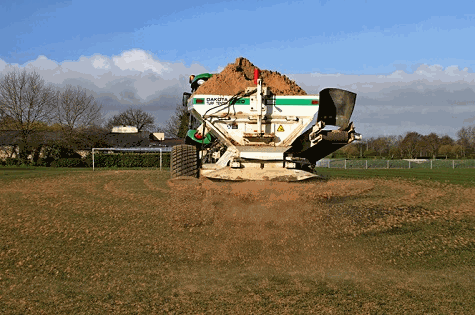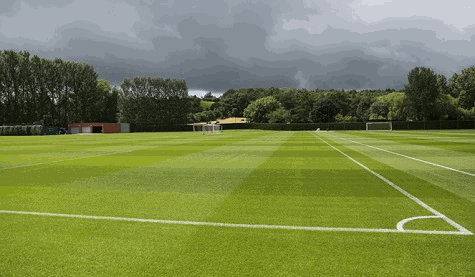Most rugby and football clubs have either finished or are now nearing the end of their playing season and hopefully should have planned quotes for their end of season renovations. The success of these renovations will dictate the future performance of the pitches.
Any major resurfacing or drainage works are usually programmed to coincide with the planned end of season renovations. In most cases clubs are reliant on getting the work done by competent sports turf contractors, who have the correct equipment for these operations.

So, it is imperative that you have secured or are seeking quotes for this work from well-known, approved contractors.
The extent and nature of the works undertaken will be dependent on a number of factors:
- Type of pitch profile system, natural soil, rootzone, fibre re-inforced sand constructed pitch
- Level of wear
- Budgets available
- Time for completion and establishment
For most clubs a basic renovation of the playing surface ideally should consist of the following works:
- Cleaning out the surface by verticutting / scarifying in two or three directions.
- Aerating the pitch (de-compacting) the pitch with a vertical punch or linear aerator.
- Top dressing with an approved sand/rootzone material usually applying anything between 50-100 tonnes of material.
- Overseeding with a decent rye grass seed mixture at a rate between 30-50g/m2 depending on the condition of the pitch
- Finally. fertilising with pre-seeding or spring/summer, applying at a rate of 25-35g/m2

Costs breakdown
The cost of these operations will be dependent on factors including the number of pitches to be completed, types of materials used, scope of works and haulage costs for delivery of machinery and materials. Budget around £7,000 for a basic renovation based on industry contractors’ rates for a single pitch area (7000m2).
Due to the economic issues the country is facing, along with the war in Ukraine, we have seen a substantial rise in the costs of raw materials and fuel / transportation costs. We are now seeing in excess of £50 per tonne for top dressing and sand depending on how much you are buying.
It’s going to cost in the region of £4000 to buy 80 tonnes of material plus the cost of spreading. Seed prices have also risen to close on £90 per 20 kilo bag of seed. Twelve bags of seed to seed a full-sized pitch will now cost in the region of £1000. On top of that you’ve got fertiliser costing around £25-30 per bag depending what NPK ration you choose, meaning it will now cost in the region of £300. Coupled with the hiring a contractor to undertake the aeration and scarifying, this will cost another £1000 per pitch.
That is a considerable investment for any club - however the benefits will be well worth the investment once you have successfully completed the works.

Once the seed has germinated it is important to keep it watered. Irrigation is essential, many grounds are beginning to show signs of stress resulting from the lack of rain we have had recently. However, with hosepipe bans in force in some parts of the country, you can only do what you can do.
Top tips
Try not to waste your water resources. Keep an eye out for leaks and check the sprinklers are working properly. It is best to water during the evening to prevent excessive water loss from evaporation.
For me the most important issue is the ongoing maintenance work you undertake during the rest of the year. Why would you invest in a proper renovation and then refrain from implementing a decent maintenance regime?
It is generally the lack of appropriate maintenance that leads to the deterioration of the pitch in the first place.
Many clubs seem to have a notion that once the season has finished, they do not need to cut the grass until the new season starts. I see far too many grounds managed in this way. Not cutting the grass leads to a poor sward density and winter playability problems. The summer is the prime time to retain the cutting height and increase the frequency of mowing.
Mowing should be continued throughout the summer period, maintaining a cutting height of around 30-40mm to encourage the grass to tiller. Grooming and verticutting are operations that remove unwanted side growth and reduce the level of debris in the sward. These operations are carried out on a regular basis, often weekly or fortnightly. They are completed in conjunction with your mowing regimes.

Fertiliser treatment and turf tonic can be continued in accordance with your annual programme. If you haven't got a fertiliser programme, have your soil tested. Try an independent soil analysis company for an impartial set of results.
Most turf professionals will be applying a summer N P K fertiliser, perhaps something with higher nitrogen that will help maintain grass colour and vigour. A slow-release fertiliser could be applied to see you through June, July and August. The choice of materials and how well they work will depend on factors such as soil type and weather, with moisture and air temperature being the catalyst for growth.
Seeding of sparse or bare areas can be carried out. This rise in temperatures will speed up germination. Use germination sheets to aid this process but remove the sheets regularly to check for diseases. Remember that without good seed to soil contact the operation is useless. Ensure you use new seed as old material may not give you the required germination rates.
Keep an eye on fungal disease attack and use approved fungicides to treat infected areas.
Don't neglect the other facilities once the playing season has finished. Remember to check posts and sockets to ensure they are safe and secure as well has giving them a well-earned coat of paint to keep them presentable.
It is important clubs keep themselves informed of any financial funding schemes that may be available for them to improve pitch facilities. The RFU and FA websites should be your first port of call followed by Sport England. Also, keep an eye out for information being posted by your local authority websites, they may also have some funding initiatives going on.